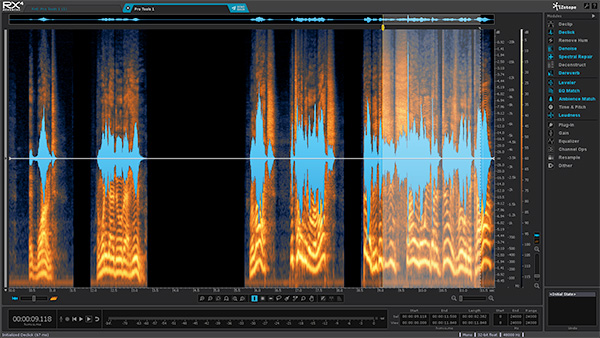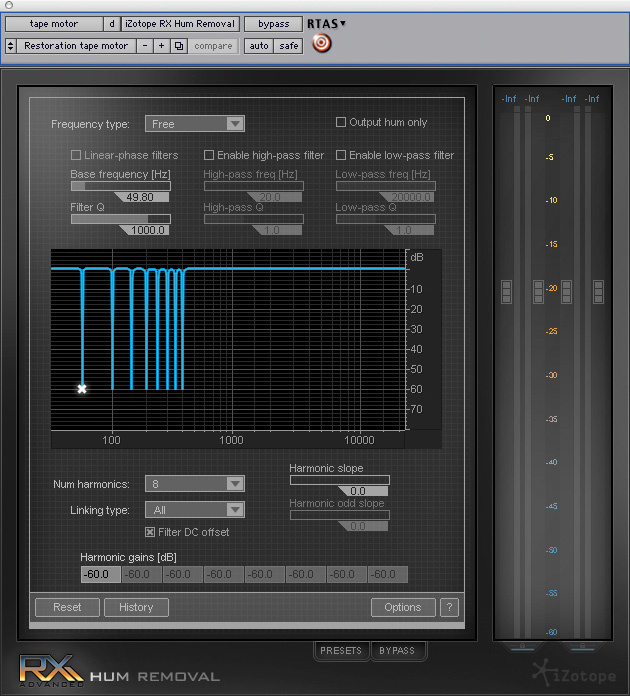This video shows how to streamline your process through a round-trip workflow with RX 4's Connect and Monitor modules in 3 easy steps. Download your free, 10. RX Monitor: When and How to Use It; Supported file formats in RX; Waves plug-ins within RX; Using RX Loudness Control within Avid Media Composer; How to use RX as an audio editor with Adobe Premiere Pro; How to use RX Connect with Avid Pro Tools; How to use RX with Ableton Live; How to use RX Connect in Steinberg Cubase or Nuendo; How to use RX.

De-click
The De-click module has three tabs: De-click, De-crackle, and Interpolate. All three are useful for repairing a wide variety of clicks, pops, and crackle, and even distortion artifacts.
De-click
De-click's sophisticated algorithm analyzes audio for amplitude irregularities and smoothes them out. This means that you can use De-click to remove a variety of short impulse noises, including clicks caused by digital errors, mouth noises, interference from cell phones, or any other audio problem caused by impulses and discontinuities in a waveform. Here's a recording with clicks before, and after click removal:
Algorithm
Controls the interpolation processing quality and configuration depending on the type of clicks and pops in the audio.
- Single-band: processes quickly and works well on very narrow 'digital' clicks
- M-band (periodic clicks): multiband processing for removing regularly repeating clicks with a wider spectrum, or regular clicks that have concentrated low or high energy (like thumps or optical soundtrack perforation noise)
- M-band (random clicks): multiband processing for wider vinyl clicks and thumps, with a protective algorithm for preserving periodic audio elements characteristic to certain instruments such as brass or vocals
Click Type
Changes the De-clicker controls to address specific kinds of clicks.
- Click: the default setting of De-clicker. Optimized to handle most clicks
- Thump: skews the click detector frequency response toward lower frequencies to tackle thumps
- Discontinuity: widens the click processing range to smooth out clicks caused by waveforms that change suddenly in amplitude
Sensitivity
Controls the sensitivity of the click detector.

Low values of this parameter will remove fewer clicks, while higher values can repair too many intervals which can result in distortion.
Frequency Skew
Tunes the frequency response of the click detector. Lower values will tune De-click to handle more low frequency thumps. High values will tune De-click to detect and process more clicks in higher frequencies.
Click Widening
Controls the processing region around each detected click. Increase this to cleanly repair clicks caused by discontinuities or other digital waveform problems.
Clicks only
Outputs the difference between the original and processed signals (suppressed clicks).
De-crackle
When an audio signal contains many clicks close together, often lower in volume, this is described subjectively as crackle. De-crackle is very effective at removing these types of audio problems, often after De-click has removed the worst offending clicks.
Quality
Controls the processing quality. Low quality offers fast processing; Medium quality will remove periodic, quickly repeating clicks; and High quality will help preserve the tonal qualities of a signal.
Use Waves In Izotope Rx 570
Strength
Controls the amount of crackle that is detected and repaired.
Amplitude skew
Skews the processing toward higher or lower amplitude crackle. If the crackle accompanies transients and other high-level signal passages (such as during clipping), set this control more to the right. If the crackle mostly happens during low-amplitude signal passages, set this control more to the left.
Crackle only
Outputs the difference between the original and processed signals (suppressed crackle).
Interpolate

Interpolate is used for repairing individual clicks, below 4000 samples in length. This mode replaces your whole selection with the replacement signal. It can be used instead of the 'pencil' tool found in another software.

De-click
The De-click module has three tabs: De-click, De-crackle, and Interpolate. All three are useful for repairing a wide variety of clicks, pops, and crackle, and even distortion artifacts.
De-click
De-click's sophisticated algorithm analyzes audio for amplitude irregularities and smoothes them out. This means that you can use De-click to remove a variety of short impulse noises, including clicks caused by digital errors, mouth noises, interference from cell phones, or any other audio problem caused by impulses and discontinuities in a waveform. Here's a recording with clicks before, and after click removal:
Algorithm
Controls the interpolation processing quality and configuration depending on the type of clicks and pops in the audio.
- Single-band: processes quickly and works well on very narrow 'digital' clicks
- M-band (periodic clicks): multiband processing for removing regularly repeating clicks with a wider spectrum, or regular clicks that have concentrated low or high energy (like thumps or optical soundtrack perforation noise)
- M-band (random clicks): multiband processing for wider vinyl clicks and thumps, with a protective algorithm for preserving periodic audio elements characteristic to certain instruments such as brass or vocals
Click Type
Changes the De-clicker controls to address specific kinds of clicks.
- Click: the default setting of De-clicker. Optimized to handle most clicks
- Thump: skews the click detector frequency response toward lower frequencies to tackle thumps
- Discontinuity: widens the click processing range to smooth out clicks caused by waveforms that change suddenly in amplitude
Sensitivity
Controls the sensitivity of the click detector.
Low values of this parameter will remove fewer clicks, while higher values can repair too many intervals which can result in distortion.
Frequency Skew
Tunes the frequency response of the click detector. Lower values will tune De-click to handle more low frequency thumps. High values will tune De-click to detect and process more clicks in higher frequencies.
Click Widening
Controls the processing region around each detected click. Increase this to cleanly repair clicks caused by discontinuities or other digital waveform problems.
Clicks only
Outputs the difference between the original and processed signals (suppressed clicks).
De-crackle
When an audio signal contains many clicks close together, often lower in volume, this is described subjectively as crackle. De-crackle is very effective at removing these types of audio problems, often after De-click has removed the worst offending clicks.
Quality
Controls the processing quality. Low quality offers fast processing; Medium quality will remove periodic, quickly repeating clicks; and High quality will help preserve the tonal qualities of a signal.
Use Waves In Izotope Rx 570
Strength
Controls the amount of crackle that is detected and repaired.
Amplitude skew
Skews the processing toward higher or lower amplitude crackle. If the crackle accompanies transients and other high-level signal passages (such as during clipping), set this control more to the right. If the crackle mostly happens during low-amplitude signal passages, set this control more to the left.
Crackle only
Outputs the difference between the original and processed signals (suppressed crackle).
Interpolate
Interpolate is used for repairing individual clicks, below 4000 samples in length. This mode replaces your whole selection with the replacement signal. It can be used instead of the 'pencil' tool found in another software.
Quality
Defines the interpolation order, which controls how complex the synthesized signal will be. Changing this control can help interpolated audio fit into its surroundings.
Instant Process Tool
The Instant Process Tool offers a smart De-click mode, which instantly applies the active settings from the De-click module's De-click and Interpolate tabs. Simply put, you may make any selection, and this mode will automatically remove all clicks present in that selection, which is particularly useful for editing a dialogue file, mismatching sample rate clicks and pops, and vinyl clicks.
Use Waves In Izotope Rx Key
If you've made a selection under 4000 samples in length, this mode will automatically use the Interpolate algorithm, and above 4000 samples, it will use the settings from the De-click tab of the De-click module. This is by design, as the De-click tab is effective on selections above 4000 samples in size, as it is able to identify clicks in relation to desirable audio, and then intelligently separate and then remove the clicks. Below 4000 samples, it is likely a small selection of an individual click, and Interpolate will fill the selection with audio information based on the surrounding audio.
Use Waves In Izotope Rx7
When using this function as part of Instant Process, the settings you have engaged in the De-click and Interpolate tabs of the De-click window will be applied. For example: if the De-click tab is indicating that the preset ‘Remove mouth clicks' is loaded, these setting will be applied every time you use the Instant Process Tool in ‘De-click' mode on a selection longer than 4000 samples.
